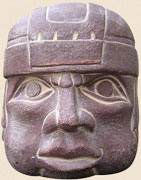Mesoamerican Olmec Heartland

Olmec Head (Fg. 3-16)
Perhaps best known for their incredibly detailed figure artworks, as defining their culture, the Mesoamerican Olmec flourished around 1400 BCE near the Bay of Campeche off the Gulf of Mexico. In addition to building large thrones and monuments, they also carved colossal sized heads weighing up to 50 tons and transported them nearly 62 miles to the Olmec heartland.
Three of six artifacts discovered in the heartland have given the impression that the Long Count calendar may have been created and used by the Olmec before the Mayans. If this proves to be true, the Mayan adoption may have a profound impact on modern understanding of the culture.
Records indicate in 800 BCE, The Great Pyramid of La Venta, the Olmec capital, was built in an orientation precisely facing eight degrees northwest, then surrounded by several colossal head monuments. It is possible for the orientation of La Venta to point toward Tenochtitlan, around fifty miles away inland. Five hundred years later, in 300 BCE, the entire Olmec civilization vanished without any hint to where they might have went or why. Is it possible the Olmec transformed or melded into another culture for survival, and even possibly overtaken by the Maya or Inca?
Olmec culture is strikingly Inca, Aztecs, and Mayans, demonstrating similar beliefs in origination, construction methods, and sharing techniques for passing along ancient knowledge. This lends merit to the idea of the Olmec merging into another powerful culture at some point. It is theorized by some researchers that the disappearance of Olmec was largely attributed to the building of new civilizations, like the Inca, Mayan and Aztec empires. The rapidly growing populations in Central Mexico split off, claiming larger areas of territory in the process.
By any means, it's an incredible mystery to even consider an entire civilization disappearing without a trace. Yet, artifacts discovered might be pointing researchers in another direction. Finding and establishing a solid link between Olmec and new-age cultures at the time may help unravel the unknowns. There is a faint trail of evidence with at least enough to understand the Olmec civilization was likely forced to adapt to a quickly changing environment. How this carried out could have happened in a number of ways such as altering traditional belief systems to become a new culture or get along with a larger one; and in this process, the giant colossal heads were left behind in tribute to the legacy.
† Article 3-16
